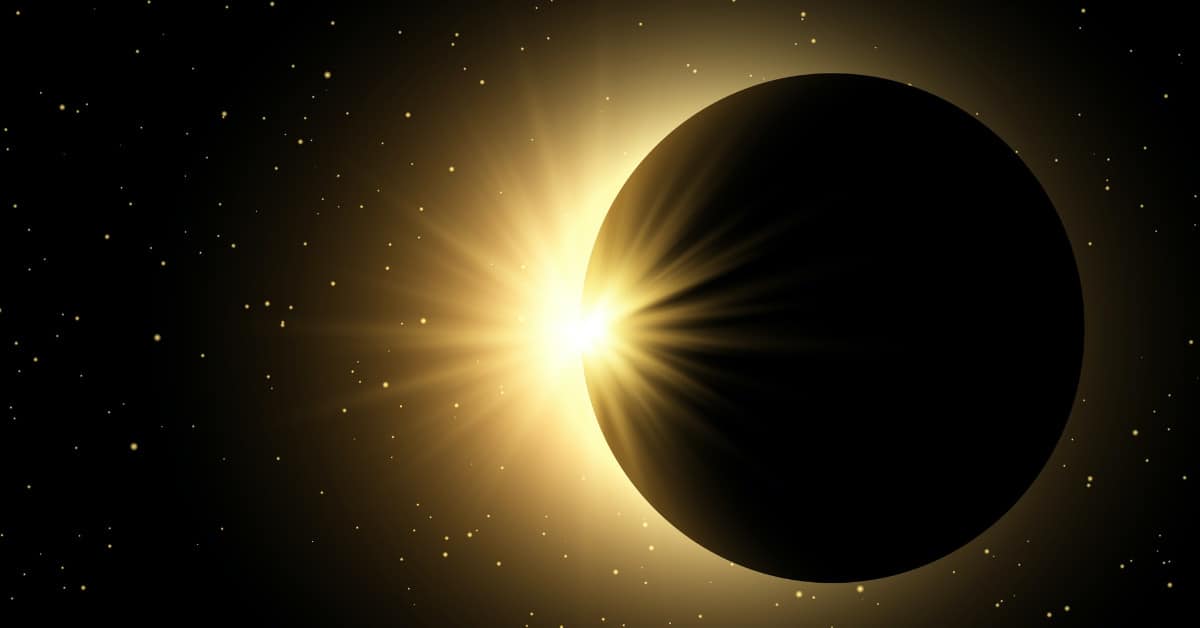Eclipses usually occur whenever celestial bodies, such as the Earth or Moon, advance between the Sun and another heavenly body, blocking sunlight from reaching the other. The Moon revolves around Earth, while the Earth orbits the Sun spinning on its axis once every twenty-four hours.
At times, the Earth shifts place between the Sun and the Moon. When this happens, Earth gets in the way of the sunlight that would usually be reflected by the Moon and causing it to shine. Instead of the Moon’s surface is lit by light from the Sun, the Earth’s shadow falls on it instead.
This occurrence causes a total eclipse of the Moon, also known as the lunar eclipse, which people can see from the Earth during the night. An eclipse of the Moon can only occur when the Moon is full. As the Moon orbits the Earth, it might sometimes advance between the Earth and Sun. This occurrence causes it to block light from the Sun from reaching the planet. When this happens, a solar eclipse is said to have occurred. The shadow of the Moon is then cast onto the Earth, causing darkness to occur.
Solar Eclipse
There are three types of eclipses of the Sun:
- Total eclipses of the Sun
- Annular eclipses of the sun
- And Partial eclipses
Total Eclipse of the Sun
It occurs when the Moon completely hides the Sun. People can see this type of solar eclipse from a minimal region on Earth. Observers witnessing this phenomenon situate themselves in the middle of its shadow on the planet. Darkness envelops the entire sky, and it gets much darker like the night. This type of eclipse usually occurs when the Earth, Moon, and Sun line up with each other in a straight line.
Annular Eclipse of the Sun
This type of eclipse occurs when the Moon is at a greater distance from the Earth. This occurrence causes it to appear smaller than usual. Moreover, the Moon does not prevent all light from the Sun from reaching the Earth’s surface. Observers of this phenomenon witness a sort of giant ring surrounding the Moon.
Partial Eclipse of the Sun
This type of eclipse occurs when the Moon, Earth and Sun misalign. Observers usually witness a dark spot on the surface of the Sun.
Hybrid eclipse
There is also a rare type known as the hybrid eclipse that happens once every 13 years. Hybrid solar eclipses arise when the Earth goes through the location where the Moon’s umbra (or darkest shadow) meets its antumbra (or the furthest rim of its light shadow). The Moon is smaller than the Sun, resulting in both its umbra and antumbra having a V-shaped form.
As the distance from the Moon increases, the umbra diminishes in width. When the umbra (shadow) finishes, at the tip of the V, the antumbra (also known as the afterglow) begins. The greater the distance from the Moon, the more the portion of the shadow becomes in diameter.
How does a hybrid eclipse look?
However, hybrid solar eclipses constitute a unique and intriguing sort of eclipse. They may be seen as complete, annular, or partial eclipses on a global scale, depending on the viewer’s position. Hybrid solar eclipses include the thinnest regions of the Moon’s umbra and antumbra. When the Moon is in the middle, and the Sun behind it, the primary phase of the eclipse is often relatively brief. Annular and total eclipses follow the same pattern: first, the Moon blocks the Sun, and then it is entirely covered by the Moon.
Key Takeaways
- Total solar eclipses occur from the Moon’s umbra, the shadow’s black core region when the Moon looks bigger than the Sun and covers it.
- Partial solar eclipses occur from the penumbra, the lighter outer component of the shadow.
- Annular solar eclipses occur from the antumbra, a half-shadow that starts where the umbra stops. The Moon appears small compared to the Sun during this sort of eclipse. Edges of the Sun are visible around the Moon.
The Lunar Eclipse
There are two types of eclipses of the Moon:
- Total eclipses of the Moon
- Partial eclipses of the Moon
Total Moon Eclipse
They occur when the Earth prevents the rays from the Sun from shining on the surface of the Moon and casting a shadow over it. When the eclipse reaches its complete stage, people watching it can see the Moon turn red. A total eclipse of the Moon takes place in the occurrence of a full moon.
During this time, Earth, Moon, and Sun line up so that the Moon appears engulfed by the Sun. When these three celestial bodies align in a linear path in the sky, they are in syzygy. Unlike the Sun, the Moon cannot produce its light, but rather because sunlight reflects its surface. The occurrence of this eclipse require that the alignment of the Moon, Sun, and Earth on a linear path. If this fails to occur, the Earth will not be able to cause the formation of a shadow on the Moon’s surface, and therefore the possibility of an eclipse occurring is minimal.
Partial Lunar Eclipse
As mentioned, a complete eclipse of the Moon occurs when the Earth, Moon, and Sun align with each other to form a linear path. A partial Moon eclipse occurs when these bodies, the Moon, Earth, and Sun, are in such a configuration where the Earth’s umbra partially shadows the Moon.
However, in that case, a penumbral lunar eclipse would occur when the exterior portion of the Earth’s shadow only lays itself on the Moon. Moreover, we can clearly state that Earth’s antumbra does not affect lunar eclipses. Despite the occurrence of a full moon being required for a complete eclipse of the Moon to take place, it can’t happen every month.
This situation occurs due to the plane of the orbit of the Moon surrounding Earth, tilted at an inclination of 5° to the plane of Earth’s orbit surrounding the Sun. It is called the ecliptic. When the orbital planes of the Sun and Moon intersect, these points are known as lunar nodes. The only way for a Moon eclipse to occur is for a full moon to be near the node of the two orbits.
Reasons for The Moon’s Appearance
Although during an eclipse of the Moon, when Earth obstructs light from the Sun from squarely reaching the surface of Earth’s Moon, it nevertheless could be seen by eye, by people. The reason behind this is that the Earth’s atmosphere contorts the Sun’s light, which is then diffused on the Moon, lighting it up.
This phenomenon occurs when sunlight is refracted towards the Earth’s surface when it travels across its atmosphere. The passing portion of light with shorter wavelengths refracts towards the surface where it is scattered and filtered out, while those with long wavelengths, such as red and orange, go through and are again refracted onto the Moon’s surface. This phenomenon creates a reddish-orange glimmer on its surface, which we can observe from Earth. It also provides the blood moon name for this occurrence.
Conclusion
People observing the Moon years ago during an eclipse noticed that the Earth’s shadow on the Moon’s surface was circular. This observation enabled them to conclude that the Earth was round. Years later, scientists are also discovering new information about the Moon, such as its surface from lunar eclipses.
Solar eclipses also provide them with opportunities to observe the corona of the Sun. This word refers to the top layer of the Sun. Scientists use ground and space-based instruments to study the corona during an annular eclipse when the Moon blocks the Sun.
See Also
Center of Mass Vs. Center of Gravity
Difference between Speed and Velocity









